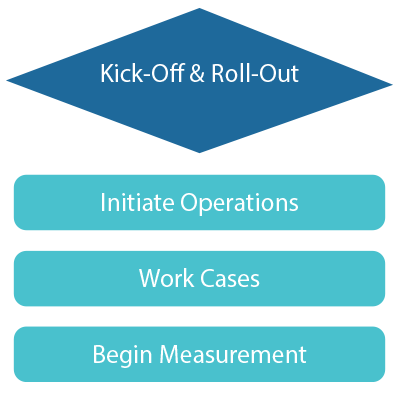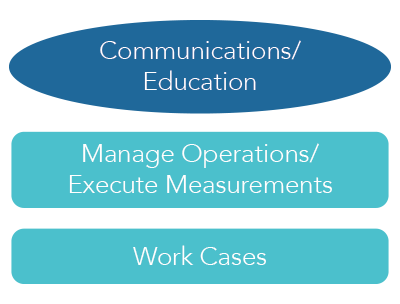
Page Menu: What You Gain | Client Industries | Featured Work
EXPERTISE + IMPACT
We are great at a few things. That’s Expertise.
Positive things happen for Clients when they use our services. That’s impact.
Read below about what you can gain, others who already have, and a small sample of our featured work, specific to organizational ombuds programs.
What You Gain
“Pacifica showed the expertise, flexibility, and intercultural sensitivity required for the successful implementation of the first Romanian organizational ombudsman program. We hope to collaborate again.”Daniel-Remus Laes
Managing Partner Romania
Contrast Management Consulting & Training S.R.L
Leading-edge practices + Expansive focus + Personal attention
Your work with Pacifica will result in actionable insights, new processes, and beneficial change.
Together we will extract unexpected benefits from the situation. Starting with your organization’s values, culture, and interests, we learn the full context. Clients find our appreciative explorations lead to new realizations, even before the intervention.
Building on discovered learnings, we deliver aligned, embedded, and integrated solutions. This results in sustainable changes and fosters more engaging, collaborative, and productive workplaces.
Your challenges inspire our efforts.
We convert miscommunications, business disruptions and organizational impediments into tangible gains. ConflictBenefit is Pacifica’s commitment, not a tag line.
Your success determines our success. Superior, measurable results are why the majority of our business comes from existing clients and referrals.
Client Industries
“Ending a business is always difficult. Pacifica made it bearable. All parties involved retained their dignity throughout. The end results were priceless.”Bob Meissner
Founder and Owner
Capitol Resources
Pacifica’s client-centric approach allows us to work in a variety of industries and on a wide range of issues. The common thread is organizations’ commitment to integrated and sustainable practices, which serve the well being of both employees and the organization. Many clients engage Pacifica after completion of their initial project because our pragmatic and highly customized approach.
Pacifica’s expertise has benefited organizations in more than a dozen industries: from higher education and non profits to energy services and heavy manufacturing to financial services and pharmaceuticals, as well as technology and government.
Following is a partial list of the organizations Pacifica has collaborated with and supported.
- Agency for Healthcare Research & Quality
Andrew Jergens Company
Baker Hughes Inc.
Blackbaud Inc.
Contrast Management Consulting
Esai Co. Ltd.
Fidelity Investments
The International Business Machines Corporation
ICANN - Kendle
Halliburton
Shell Energy North America
OMV Petrom S.A.
Novo Nordisk A/S
Teach for America
Toyota Tsusho of America, Inc.
University of Colorado Boulder
United States Air Force
Featured Work
“In my tenure with the o3, I have reflected on how well you designed our office, communicated with leadership, and set us up for success.”Bonnie Bonnivier
Ombuds
Baker Hughes Inc.
Pacifica creates value for clients in many ways. Every Pacifica engagement expands the essential element of open human communications. These three examples highlight just one – ombuds-specific perspectives and process. Let’s discuss this work, or connect on your project needs.
How Ombuds Programs Complement Formal Channels
Four essential characteristics define organizational ombuds programs:
Independence — Outside the management structure • Makes no management decisions
Neutrality — Cannot compel any particular action • Not an advocate • Only represents fair, quality process
Informality — Not a place of notice • Does not participate in formal processes • Initiator retains issue responsibility
Confidentiality — Ensures privacy for early and open consideration • No permanent, identifying case records kept
These attributes ensure ombuds programs operate unlike human resources, legal, compliance, or other formal functions. Additionally, these differences provide intrinsic value to an organization. An ombuds provides individualized, off-the-record, guidance that may include determining which formal channel best addresses the issue or concern.
“I hired Pacifica because we are not well understood. John and Andrea had specific ideas about how to increase our reach.”Tom Sebok
Director, Ombuds Office
University of Colorado Boulder
Because of ombuds’ limited authority, managers’ responsibilities are not replaced or suspended. Formal functions report increased case loads when a fully supported, aligned, embedded, and integrated (AEI) ombuds program exists. This is because members of the organization know more. In addition to presenting all the available options and choices, an ombuds can help the employee utilize other resources, collect information, or establish a dedicated communication channel. For managers and others, an ombuds is a safe place to sound-out an issue or identify ways to manage a challenge, thus advancing employee skills and capacity. An ombuds’ “no-agenda perspective” provides unofficial, upward feedback to leadership and produces the best, early opportunity for the organization to internally self-correct, which preserves resources, relationships, and reputations.
Comparing Characteristics
| Function/Task | Compliance | Health, Safety, Security and Environment |
Human Resources |
Legal | Managers | Organizational Ombuds Program |
|---|---|---|---|---|---|---|
| Notice to the Organization | ✔ | ✔ | ✔ | ✔ | ✔ | Independent |
| Designated Neutral | — | — | — | — | — | ✔ |
| Status | Formal | Formal | Formal | Formal | Formal | Informal |
| Confidential, Supported by Implied Contract | — | — | — | — | — | Only exception— threat of imminent serious, physical harm, as determined only by the ombuds |
| Makes and Enforces Policy | ✔ | ✔ | ✔ | ✔ | ✔ | Helps employees understand rules, regulations, and protocols |
| Formally Investigates Makes Official Findings |
✔ | ✔ | ✔ | ✔ | ✔ | Can gather data to assist an employee with an issue |
| Keeps Permanent Case Records for the Organization |
✔ | ✔ | ✔ | ✔ | ✔ | Keeps records only to manage case work; Aggregates data to recognize & present trends, and develop a program's annual report |
| Determines Outcomes, Compels Actions |
✔ | ✔ | ✔ | ✔ | ✔ | Voluntary resource; No official authority; Does not dictate outcomes or actions |
* Although other formal channels allow for confidentiality, it is limited and incomplete compared to ombuds programs.
The Design + Build Overview of Organizational Ombuds Programs
(Click Individual Steps to View)
All rights reserved | Pacifica Human Communications, LLC © 2014 | info@conflictbenefit.com | Privacy Policy






